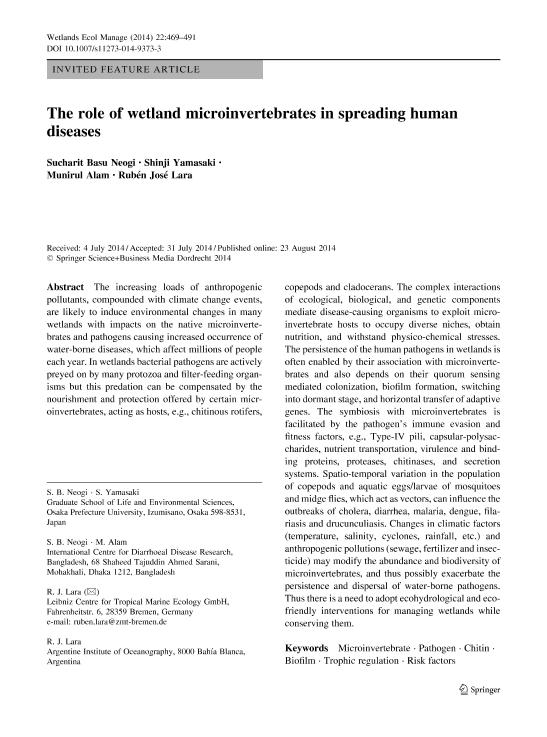Artículo
The role of wetland microinvertebrates in spreading human diseases
Fecha de publicación:
08/2014
Editorial:
Springer
Revista:
Wetlands Ecology And Management
ISSN:
0923-4861
Idioma:
Inglés
Tipo de recurso:
Artículo publicado
Clasificación temática:
Resumen
The increasing loads of anthropogenic pollutants, compounded with climate change events, are likely to induce environmental changes in many wetlands with impacts on the native microinvertebrates and pathogens causing increased occurrence of water-borne diseases, which affect millions of people each year. In wetlands bacterial pathogens are actively preyed on by many protozoa and filter-feeding organisms but this predation can be compensated by the nourishment and protection offered by certain microinvertebrates, acting as hosts, e.g., chitinous rotifers, copepods and cladocerans. The complex interactions of ecological, biological, and genetic components mediate disease-causing organisms to exploit microinvertebrate hosts to occupy diverse niches, obtain nutrition, and withstand physico-chemical stresses. The persistence of the human pathogens in wetlands is often enabled by their association with microinvertebrates and also depends on their quorum sensing mediated colonization, biofilm formation, switching into dormant stage, and horizontal transfer of adaptive genes. The symbiosis with microinvertebrates is facilitated by the pathogen’s immune evasion and fitness factors, e.g., Type-IV pili, capsular-polysaccharides, nutrient transportation, virulence and binding proteins, proteases, chitinases, and secretion systems. Spatio-temporal variation in the population of copepods and aquatic eggs/larvae of mosquitoes and midge flies, which act as vectors, can influence the outbreaks of cholera, diarrhea, malaria, dengue, filariasis and drucunculiasis. Changes in climatic factors (temperature, salinity, cyclones, rainfall, etc.) and anthropogenic pollutions (sewage, fertilizer and insecticide) may modify the abundance and biodiversity of microinvertebrates, and thus possibly exacerbate the persistence and dispersal of water-borne pathogens. Thus there is a need to adopt ecohydrological and eco-friendly interventions for managing wetlands while conserving them.
Palabras clave:
Pathogens
,
Chitin
,
Biofilm
,
Risk Factors
Archivos asociados
Licencia
Identificadores
Colecciones
Articulos(IADO)
Articulos de INST.ARG.DE OCEANOGRAFIA (I)
Articulos de INST.ARG.DE OCEANOGRAFIA (I)
Citación
Neogi, Sucharit Basu; Yamasaki, Shinji; Alam, Munirul; Lara, Ruben Jose; The role of wetland microinvertebrates in spreading human diseases; Springer; Wetlands Ecology And Management; 22; 5; 8-2014; 469-491
Compartir
Altmétricas




